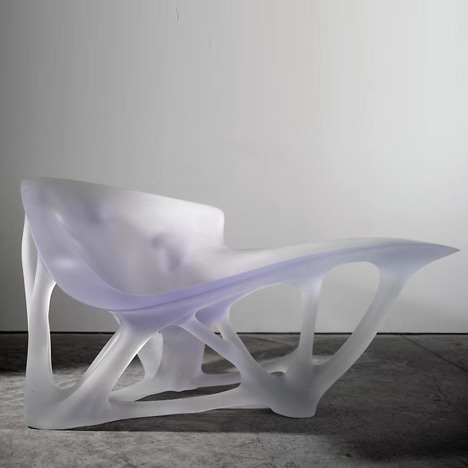London Design Festival: the V&A museum in London will show off its latest contemporary furniture acquisitions during London Design Festival next week, including Joris Laarman's 2006 Bone chaise and mould (pictured above).
A donation from The Design Fund to Benefit the V&A has enabled the museum to acquire pieces by three international furniture makers: Dutch designer Joris Laarman, Eindhoven graduate Yuya Ushida and Swiss designer Boris Dennler.
Laarman's Bone chaise has been acquired along with the positive mould used in its manufacturing. The chaise, which was computer-designed to provide maximum support from the minimum possible mass, was originally featured on Dezeen after its launch at Design Miami in 2006.
Also acquired by the museum was Ushida's SOFA_XXXX (pictured above), a piece of expandable seating made from nearly 8000 bamboo chopsticks. Dezeen interviewed Ushida about his expandable system last year, and we also posted a movie in which he demonstrates the bamboo sofa.
The final acquisition is Dennler's Wooden Heap (pictured above), a set of drawer units that looks like a woodpile and can be stacked in different configurations. This piece will become part of the permanent display in the V&A's new furniture gallery after London Design Festival.
See all our stories about the V&A »
See all our stories about Joris Laarman »
See all our stories about London Design Festival 2012 »
Here's the full press release:
The Design Fund to Benefit the V&A Announces New Contemporary Furniture Acquisitions
September 2012
This year, the Design Fund to Benefit the V&A has enabled the Museum to acquire four new contemporary pieces for the collections by three international designers – Bone Chaise and its positive mould by Dutch designer Joris Laarman, SOFA_XXXX by Eindhoven graduate Yuya Ushida and Wooden Heap, a drawer unit by Swiss designer Boris Dennler (BorisLab).
They will all go on display at the Museum for the first time during London Design Festival (14-23 September). Wooden Heap, will also become part of the permanent display in the V&A’s new furniture gallery, The Dr. Susan Weber Gallery, when it opens in December, alongside an object acquired by last year’s fund, Fractal Table II.
The Design Fund to Benefit the V&A was set up in March 2011 by Yana Peel, arts patron and CEO of Intelligence Squared Group, to engage private patrons to support the V&A in acquiring the best in contemporary design. Over the last two years a group of patrons, chaired by designer Francis Sultana, has enabled the V&A to buy a total of 12 pieces of furniture by such designers as Fredrikson Stallard, nendo and BCXSY.
These new acquisitions significantly enhance the V&A’s holding of contemporary design, a collection which reflects what is new, influential, innovative or experimental, and what is representative of contemporary trends in design and society. The collection spans all aspects of design and art including fashion, furniture, craft objects, product and graphic design, digital media, architecture, photography, prints and drawings.
Martin Roth, Director of the V&A, said: “The generosity of Yana Peel and the patrons of the Design Fund is vital to the V&A. As the world's leading museum of art and design it is essential that we are able to collect contemporary design, not only so we can reflect current practice but also to maintain significant collections for future generations."
Yana Peel, Founder of the Design Fund to Benefit the V&A, said: “In this golden era of design in Britain, it has been a privilege to donate to the V&A the largest gift to date for contemporary acquisitions. The generosity of Design Fund patrons ensures the best examples of contemporary design can find a permanent home in the Museum’s collection.”
Details of the new acquisitions
Joris Laarman (The Netherlands)
Bone Chaise and mould, 2006
Joris Laarman graduated from the Design Academy Eindhoven in 2003 and established the ‘Joris Laarman Lab’ in 2004. The studio describes itself as an ‘experimental playground … to study and shape the future’ and their work embraces science and technology as much as craft. The starting point for the chaise was to define the seat and back and the points on the floor which would carry the chair. A software programme which mimics the way bones grow created the design of the supporting structure, providing maximum support from the minimum possible mass. The V&A is purchasing both the finished polyurethane chaise and the positive mould used in its manufacture.
Yuya Ushida (Japan)
SOFA_XXXX, 2011-12
SOFA_XXXX was the graduation piece by young designer Yuya Ushida from the Design Academy Eindhoven. The design arose from a desire to create expandable seating for a small space. The construction is based on a module of only eight elements that plug into each other: four different lengths of sticks made from trimmed bamboo chopsticks, three rings and a hinged joint made of stainless steel. A total of 7,710 sticks, 3,855 joints and 1,669 rings are assembled by hand to create the sofa. Chopsticks were not originally specified but an inability to source the correct size bamboo in Europe led the designer to try chopsticks which, by coincidence, were the correct size for the project. A version in glass fibre reinforced polyamide plastic, along with a smaller stool, is being produced by Dutch manufacturer Ahrend. Although the elements can be mass produced, assembly is still by hand.
Boris Dennler (Switzerland)
Wooden Heap, 2012
Wooden Heap is a transformable furniture form composed of six identical drawer units. These can be stacked in various configurations, appropriate for an object seemingly made of stacked pieces of wood. The form recalls 18th- and 19th-century six-drawer chiffoniers while being resolutely contemporary. Swiss designer Dennler devotes himself to creating experimental, sometimes radical objects, often made from recycled materials or referencing re-use. This cabinet selfconsciously refers to 1960s-70s anti-design while revelling in notions of the hidden and the surprise.

